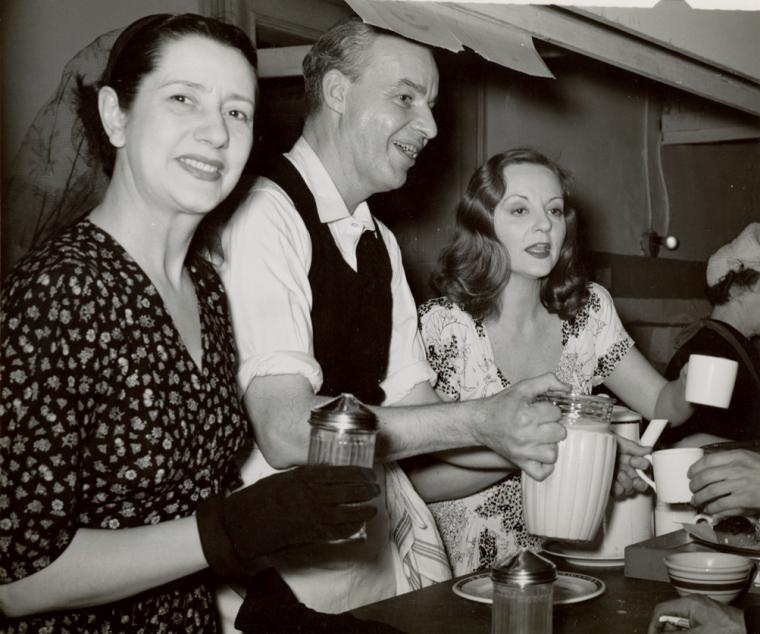Popular Music, Vandamm
Sinatra at the Stage Door Canteen
We have received many questions recently about this, the secondary key image for the exhibition. In these months between the anniversaries of VE and VJ Days, there has also been a rise in interest about NYPL and especially LPA holdings on World War II activity comparable to those featured in the Wachenheim Gallery exhibition on World War I, Over Here: The Fight for the American Mind. So, welcome to the Stage Door Canteen.
We discovered the image when the New York Public Library for the Performing Arts museum staff and summer 2014 interns were asked by our GRAMMY Museum colleagues to document Sinatra’s early 1940s NY career. The photograph appears in the section of the exhibition devoted to his early recordings and fan following. The GRAMMY Curator, Bob Santelli, wanted a photograph of him close to his audience—a physical set-up unsuited to the huge picture palaces in which the big bands played. He liked this image since it shows the young women leaning forward with adoring smiles and the young men leaning away, scowling. There is a low ceiling with a narrow staircase in the back. So where was he? Most of our photographs of Sinatra in this period were in a nightclub, theater or recording studio, but none of those seemed right for this audience. The aprons were a clue. We were especially pleased to discover that the image might show him performing at the Stage Door Canteen below the 44th St. Theater in New York, conveniently close to the Paramount Theater stage door.
The New York Canteen, and others across the country, were projects of the American Theatre Wing, War Service Inc. Like the World War I era Stage Women’s War Relief, the Theatre Wing developed and funded a variety of activities from fundraising to hospital work, staffed by volunteers. The Canteens had the greatest visibility and were memorialized in popular songs and films. While there were daily performances for the service men/women, the Canteens were best remembered for the stars serving food or clearing dishes. It was good for publicity and undoubtedly lived on in the memories of visiting servicemen. Frank Sinatra was known for his committment to volunteer performances at state-side bond rallies and military camps. Those short aprons worn by the adoring fans made us question the identification briefly. The standard volunteer aprons had a bib section and were decorated with wide red, white and blue vertical stripes. And most of the standard badges, decorated with a variant of the Canteen logo of a comedy mask with wings, cut off the Greek comedy mask under the nose. The male volunteers were given the full face mask. We wondered whether the younger, occasional volunteers were issued the red apron to wear at work. Curators worry about this kind of thing.
Many of the sources of Stage Door Canteen information in books and on-line bemoan that little primary source material exists. But, we discovered a rich collection here at LPA that included design detail because the papers came from women for whom design details mattered. The theater women volunteering with the Canteens included those in management and technical fields. The Papers of Emeline Clark Roche (*T-MSS 1996-016) , a set designer and technical director, include technical drawings for the New York Canteen, as well as the mobile stage used for the Wing’s Lunchtime Follies, which provided free performances at the NY/NJ docks and factories. The collection also includes the Papers of Jane Cowl, famed actress and dramatist who had been actively involved with both the Stage Women’s war Relief and the American Theatre Wing.
LPA has a collection of photo scrapbooks documenting the New York and other Canteens, as well as other Wing activities. The key image was there, but, like most of the photographs, are uncredited. There are credited press images images by Florence Vandamm and Talbot (Joseph Abeles). The blog’s second image is a Vandamm showing (left to right) Lynn Fontanne, Alfred Lunt and Tallulah Bankhead serving coffee. It may have been taken at the opening on March 2, 1942, when newspapers reported that they were all present. More of the scrapbook content and a group of small format photographs can now be found in the Digital Collection.
Read E-Books with SimplyE
 With your library card, it's easier than ever to choose from more than 300,000 e-books on SimplyE, The New York Public Library's free e-reader app. Gain access to digital resources for all ages, including e-books, audiobooks, databases, and more.
With your library card, it's easier than ever to choose from more than 300,000 e-books on SimplyE, The New York Public Library's free e-reader app. Gain access to digital resources for all ages, including e-books, audiobooks, databases, and more.
If you don’t have an NYPL library card, New York State residents can apply for a digital card online or through SimplyE (available on the App Store or Google Play).
Need more help? Read our guide to using SimplyE.

Comments
The photo
Submitted by Nancy K (not verified) on May 21, 2015 - 10:30am